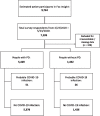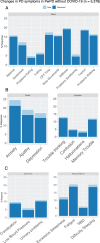The Effect of the COVID-19 Pandemic on People with Parkinson's Disease
- PMID: 32925107
- PMCID: PMC7683050
- DOI: 10.3233/JPD-202249
The Effect of the COVID-19 Pandemic on People with Parkinson's Disease
Abstract
Background: The effect of the COVID-19 pandemic on people with Parkinson's disease (PD) is poorly understood.
Objective: To rapidly identify areas of need and improve care in people with PD during the COVID-19 pandemic, we deployed a survey to assess COVID-19 symptoms and the pandemic's effect among those with and without COVID-19.
Methods: People with and without PD participating in the online study Fox Insight (FI) were invited to complete a survey between April 23 and May 23, 2020. Among people reporting COVID-19 diagnoses, we compared symptoms and outcomes in people with and without PD. Among people not reporting COVID-19, we assessed access to healthcare and services and PD symptoms.
Results: 7,209/9,762 active FI users responded (approximately 74% response rate), 5,429 people with PD and 1,452 without PD. COVID-19 diagnoses were reported by 51 people with and 26 without PD. Complications were more frequent in people with longer PD duration. People with PD and COVID-19 experienced new or worsening motor (63%) and nonmotor (75%) symptoms. People with PD not diagnosed with COVID-19 reported disrupted medical care (64%), exercise (21%), and social activities (57%), and worsened motor (43%) and non-motor (52%) symptoms. Disruptions were more common for those living alone, with lower income and non-White race.
Conclusions: The COVID-19 pandemic is associated with wide-ranging effects on people with PD, and certain groups may be at particular risk. FI provides a rapid, patient-centered means to assess these effects and identify needs that can be used to improve the health of people with PD.
Keywords: COVID-19; Parkinson’s disease; health care access; social isolation; telemedicine.
Conflict of interest statement
E. G. Brown receives research support from the Michael J. Fox Foundation and the Gateway Institute for Brain Research Inc. He has received research support from Biogen Inc within the last two years. He has received honorarium from NEJM Knowledge+ as the Neurology Section Editor, and has received consulting fees from Oscar Health and Rune Labs Inc within the last two years.
L. M. Chahine receives research support from the Michael J Fox Foundation, UPMC Competitive Medical Research Fund, and University of Pittsburgh, is study site investigator for a study sponsored by Biogen, receives research support from the National Institutes of Health, receives royalties from Elsevier (for authorship), and receives royalties from Wolters Kluwel (for authorship).
S. M. Goldman’s research is supported by grants from the Michael J. Fox Foundation, VA CSR&D Merit, ATSDR/CDC, NIOSH, Department of Defense, Biogen Inc, UCSF Academic Senate.
M. Korell receives research support from the Michael J. Fox Foundation.
E. Mann reports nothing to disclose.
D. Kinel reports nothing to disclose.
V. Arnedo is an employee of The Michael J. Fox Foundation for Parkinson’s Research.
K. Marek reports grants from the Michael J Fox Foundation, Dept of Defense and personal fees from GE Healthcare, Roche, Neuropore, Proclara, UCB, Lysosomal Therapeutics, Inc, Neuroderm, Denali, Takeda, Samumed, Cerapsir, HANDL, Samus, Biohaven, Neuron23, Aprinoia, Genentech, Invicro.
C. M. Tanner reports grants from Parkinson Foundation, Gateway LLC, Roche/Genentech, Parkinson Study Group, Michael J Fox Foundation, NIH/NIA, NIH/NINDS, VA Merit, Dept of Defense, Biogen Idec, Roche Genentech and personal fees from Biogen Idec, Acorda, Adamas Therapeutics, Amneal, CNS Ratings, Grey Matter LLC, Northwestern University, Partners, Harvard U, Guidemark Health, Acadia, Neurocrine, Lundbeck and Cadent.
Figures




References
Publication types
MeSH terms
LinkOut - more resources
Full Text Sources
Other Literature Sources
Medical
Miscellaneous

